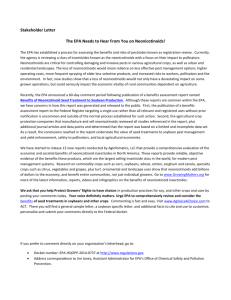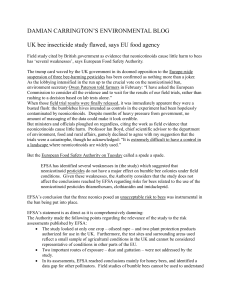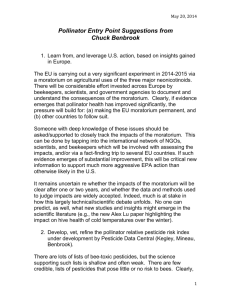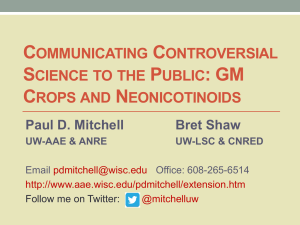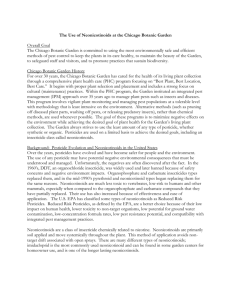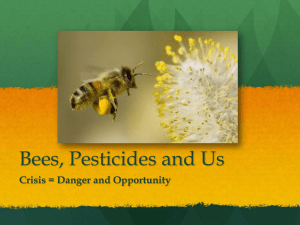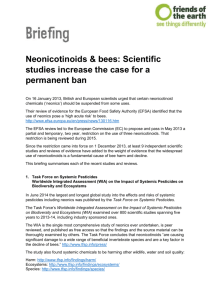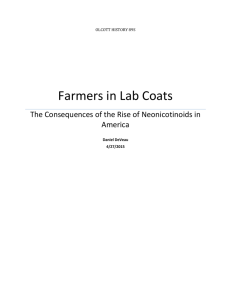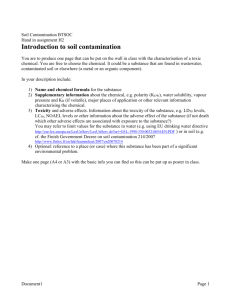Main Proposal - Minnesota Senate
advertisement
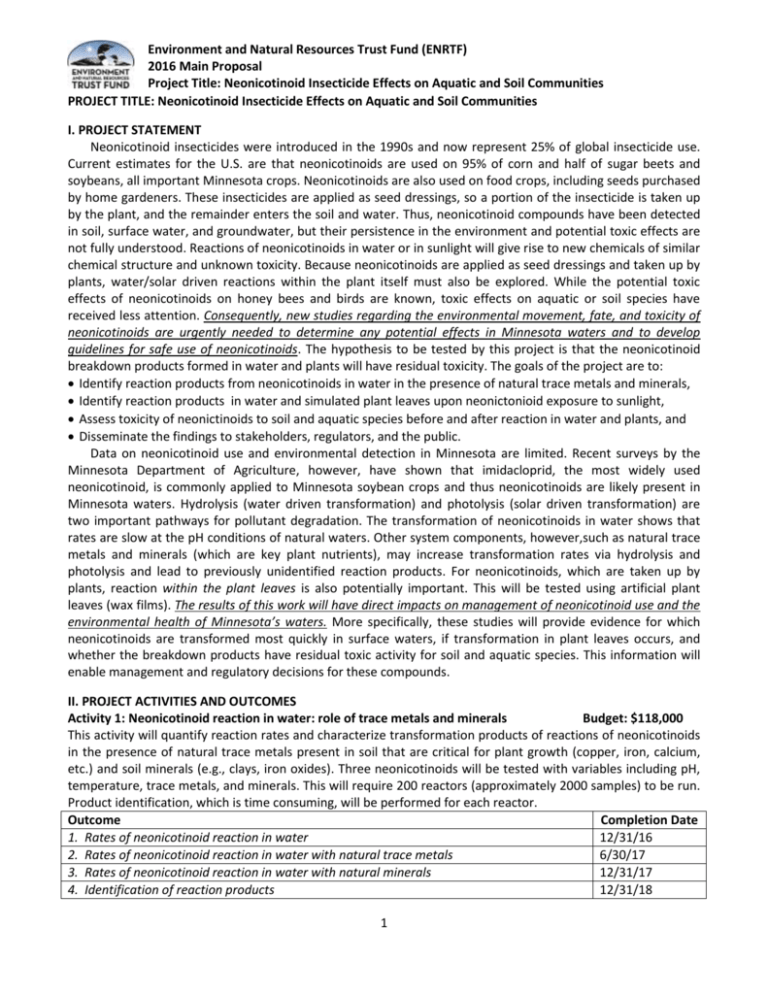
Environment and Natural Resources Trust Fund (ENRTF) 2016 Main Proposal Project Title: Neonicotinoid Insecticide Effects on Aquatic and Soil Communities PROJECT TITLE: Neonicotinoid Insecticide Effects on Aquatic and Soil Communities I. PROJECT STATEMENT Neonicotinoid insecticides were introduced in the 1990s and now represent 25% of global insecticide use. Current estimates for the U.S. are that neonicotinoids are used on 95% of corn and half of sugar beets and soybeans, all important Minnesota crops. Neonicotinoids are also used on food crops, including seeds purchased by home gardeners. These insecticides are applied as seed dressings, so a portion of the insecticide is taken up by the plant, and the remainder enters the soil and water. Thus, neonicotinoid compounds have been detected in soil, surface water, and groundwater, but their persistence in the environment and potential toxic effects are not fully understood. Reactions of neonicotinoids in water or in sunlight will give rise to new chemicals of similar chemical structure and unknown toxicity. Because neonicotinoids are applied as seed dressings and taken up by plants, water/solar driven reactions within the plant itself must also be explored. While the potential toxic effects of neonicotinoids on honey bees and birds are known, toxic effects on aquatic or soil species have received less attention. Consequently, new studies regarding the environmental movement, fate, and toxicity of neonicotinoids are urgently needed to determine any potential effects in Minnesota waters and to develop guidelines for safe use of neonicotinoids. The hypothesis to be tested by this project is that the neonicotinoid breakdown products formed in water and plants will have residual toxicity. The goals of the project are to: Identify reaction products from neonicotinoids in water in the presence of natural trace metals and minerals, Identify reaction products in water and simulated plant leaves upon neonictonioid exposure to sunlight, Assess toxicity of neonictinoids to soil and aquatic species before and after reaction in water and plants, and Disseminate the findings to stakeholders, regulators, and the public. Data on neonicotinoid use and environmental detection in Minnesota are limited. Recent surveys by the Minnesota Department of Agriculture, however, have shown that imidacloprid, the most widely used neonicotinoid, is commonly applied to Minnesota soybean crops and thus neonicotinoids are likely present in Minnesota waters. Hydrolysis (water driven transformation) and photolysis (solar driven transformation) are two important pathways for pollutant degradation. The transformation of neonicotinoids in water shows that rates are slow at the pH conditions of natural waters. Other system components, however,such as natural trace metals and minerals (which are key plant nutrients), may increase transformation rates via hydrolysis and photolysis and lead to previously unidentified reaction products. For neonicotinoids, which are taken up by plants, reaction within the plant leaves is also potentially important. This will be tested using artificial plant leaves (wax films). The results of this work will have direct impacts on management of neonicotinoid use and the environmental health of Minnesota’s waters. More specifically, these studies will provide evidence for which neonicotinoids are transformed most quickly in surface waters, if transformation in plant leaves occurs, and whether the breakdown products have residual toxic activity for soil and aquatic species. This information will enable management and regulatory decisions for these compounds. II. PROJECT ACTIVITIES AND OUTCOMES Activity 1: Neonicotinoid reaction in water: role of trace metals and minerals Budget: $118,000 This activity will quantify reaction rates and characterize transformation products of reactions of neonicotinoids in the presence of natural trace metals present in soil that are critical for plant growth (copper, iron, calcium, etc.) and soil minerals (e.g., clays, iron oxides). Three neonicotinoids will be tested with variables including pH, temperature, trace metals, and minerals. This will require 200 reactors (approximately 2000 samples) to be run. Product identification, which is time consuming, will be performed for each reactor. Outcome Completion Date 1. Rates of neonicotinoid reaction in water 12/31/16 2. Rates of neonicotinoid reaction in water with natural trace metals 6/30/17 3. Rates of neonicotinoid reaction in water with natural minerals 12/31/17 4. Identification of reaction products 12/31/18 1 Environment and Natural Resources Trust Fund (ENRTF) 2016 Main Proposal Project Title: Neonicotinoid Insecticide Effects on Aquatic and Soil Communities Activity 2: Solar effects on neonicotinoids in water and plants Budget: $113,000 Photolysis experiments will be performed in pure water solutions using artificial sunlight (which provides control and reproducibility) as an energy source. Validation of results will use natural sunlight and natural waters. Following these experiments, photolysis rates in “artificial leaves” (cuticular wax films) will be investigated. This method has been used in recent pesticide transformation studies to mimic the chemical environment of a plant leaf. The waxy leaf environment may lead to different transformation rates and products. Again, three neonicotinoids will be used for experiments, with a total of at least 100 experiments (1000 samples) required. Finally, transformation products will be identified for reactions in water and “artificial leaves” to find any structural or comparative differences in product compositions. Outcome Completion Date 1. Rates of solar-driven neonicotinoid reaction in water 6/30/17 2. Rates of solar-driven neonicotinoid reaction in “artificial leaves” 6/30/18 3. Identification of products of aqueous and “artificial leaf” photolysis 12/31/18 4. Dissemination of Activity 1 & 2 findings via open access journal publication(s) 12/31/18 Activity 3: Toxicity of transformation products to soil and aquatic species Budget: $181,000 Toxicity tests will be performed with the neonicotinoid insecticides, the reaction mixtures from Activity 1 and 2, and, when possible, with individual identified/isolated transformation products. The potential impacts on soil and aquatic organisms need to be explored to fully evaluate impacts of neonicotinoids. The tests will use springtails (a soil arthropod commonly used in assessment of environmental contaminants), mosquito larvae, and tadpoles from three native frog species that breed in vernal pools, often impacted by agricultural runoff. This will provide a representation of a range of species native to Minnesota. For each reaction condition, a minimum of seven doses are needed for each species tested (up to 2500 total experiments). Efforts will focus on reactions where the reaction product is likely to have residual activity based on its structure. Outcome Completion Date 1. Quantify levels of neonicotinoids and breakdown products toxic to springtails 6/30/18 2. Quantify levels of neonicotinoids and breakdown products toxic to mosquito larvae 12/31/18 3. Quantify levels of neonicotinoids and breakdown products toxic to tadpoles (3 species) 6/30/19 4. Dissemination of findings via open access journal publication(s) 6/30/19 III. PROJECT STRATEGY A. Project Team/Partners: The project will be led by William Arnold (U of MN, Department of Civil, Environmental, and Geo- Engineering), who will be responsible for Activities 1 and 2, and Ann Fallon (U of MN, Department of Entomology) who will be responsible for Activity 3. The team will consist of two graduate and two undergraduate student researchers. Arnold is an expert in chemical reactions of pollutants in water, and Fallon is an expert in insecticide toxicology, insecticide resistance, insect physiology and molecular biology. B. Project Impact and Long-Term Strategy: This project will provide an understanding of neonicotinoid interactions with the natural environment and their potential transformation pathways. Results of the proposed work will provide a strong basis for evaluating the persistence and toxicity of neonicotinoids thus allowing for informed use, management, and, if needed, regulatory actions. Additionally, these studies will provide the first evidence of neonicotinoid hydrolysis and photolysis beyond simple baseline experiments in pure water solutions. The results will be disseminated via open-access scientific literature and publically available reports. C. Timeline Requirements: The project will be completed in a three year period. The experiments to gather sufficient data to discern neonicotinoid hydrolysis and photolysis trends, the method development for product identification, and the toxicity testing are all time consuming and require attention to detail and replication. 2
